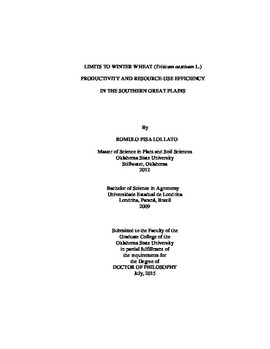| dc.contributor.advisor | Edwards, Jeff | |
| dc.contributor.author | Lollato, Romulo Pisa | |
| dc.date.accessioned | 2016-09-29T18:41:03Z | |
| dc.date.available | 2016-09-29T18:41:03Z | |
| dc.date.issued | 2015-07 | |
| dc.identifier.uri | https://hdl.handle.net/11244/45276 | |
| dc.description.abstract | Wheat yields have been stagnant at ~2 Mg ha-1 for 30-yr in the southern Great Plains and evidences suggest yields are below the potential (Yw). Our objectives were to quantify the wheat Yw and determine its meteorological drivers, and to assess how acidic soils restrict yields of wheat varieties. A field study evaluated forage and grain yields of four wheat varieties grown in a 4.1-7.6 soil pH gradient during six site-years across Oklahoma. Minimum soil pH for maximum forage yield ranged from 5.5 to 6 and for maximum grain yield ranged from 4.8 to 5.8. Tolerant varieties improve wheat yields in acidic soils. Secondly, 29 site-years were sampled for plant available water at wheat sowing (PAWs) to test mechanistic soil-water balance models and develop empirical models to predict PAWs. Mechanistic models initiated during early summer-fallow using lognormally-distributed starting PAW or empirical models were able to predict PAWs with +-30% accuracy. Third, wheat was grown under non-limiting conditions during 11 site-years across Oklahoma to determine Yw. Greatest irrigated Yw was 7.7 Mg ha-1 and rainfed Yw ranged from 3 to 7.1 Mg ha-1. Intensive management led to radiation-use efficiency (RUE) of 1.9 g MJ-1 and water-use efficiency (WUE) of 12.6 kg ha-1 mm-1. A crop simulation model was calibrated using this dataset and used to predict Yw at 37 locations for 28-yr across Texas, Kansas, and Oklahoma and assess meteorological variables dictating Yw. Mean Yw increased from 3.5 Mg ha-1 to 7 Mg ha-1 west to east (>103W to 98.5W) and plateaued east of 98.5W. Interannual Yw variability was greater in the west (30% < CV < 50%) and decreased towards east (CV < 20%). Precipitation and PAWs explained 81.7% of Yw variation in the west and solar radiation 86.9% in the east. Water-productivity (24.2 to 10.2 kg ha-1 mm-1) and transpiration-efficiency (25.8 to 22.5 kg ha-1 mm-1) decreased, and RUE (0.43 to 1.15 g MJ-1) increased, from west to east. While variety selection can improve acidic soils' productivity, great interannual Yw variability likely renders producers reluctant when investing in the wheat crop and possibly contributes to the regional yield stagnation. | |
| dc.format | application/pdf | |
| dc.language | en_US | |
| dc.rights | Copyright is held by the author who has granted the Oklahoma State University Library the non-exclusive right to share this material in its institutional repository. Contact Digital Library Services at lib-dls@okstate.edu or 405-744-9161 for the permission policy on the use, reproduction or distribution of this material. | |
| dc.title | Limits to winter wheat (Triticum aestivum L.) productivity and resource-use efficiency in the southern Great Plains | |
| dc.contributor.committeeMember | Ochsner, Tyson E. | |
| dc.contributor.committeeMember | Arnall, Daryl Brian | |
| dc.contributor.committeeMember | Goad, Carla Lynn | |
| osu.filename | Lollato_okstate_0664D_14129.pdf | |
| osu.accesstype | Open Access | |
| dc.type.genre | Dissertation | |
| dc.type.material | Text | |
| thesis.degree.discipline | Crop Science | |
| thesis.degree.grantor | Oklahoma State University | |
